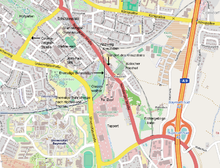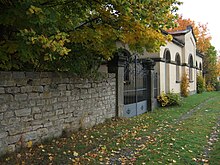Kreuzstein (Bayreuth)
Kreuzstein is a district of Bayreuth .
Surname
The name of the district can be traced back to the cross stone from the 16th century at Nürnberger Straße 5 . It was placed as a mark of atonement and a memorial stone to commemorate a murdered person at the crime scene, which, however, was closer to the city on the Creußener Fuhre, the current Nürnberger Straße. The Bayreuth citizen's son "Kunzen Vogel" stabbed the white tanner Jakob Dülp there in 1583 , the perpetrator "escaped" and was never caught. In 1761 the Kreuzstein was moved to its current location.
location
The district is framed by the residential area east of Cosima-Wagner-Straße, by the Fichtelgebirgsbahn , by the Oberkonnersreuth district and by the university campus . The Kreuzsteinbad bathing establishment is already on the eastern edge of the Birken district .
History and description

The house at Nürnberger Strasse 5, at the northwest corner of which the Kreuzstein stands, used to belong to the municipality of Oberkonnersreuth as property no. Together with the Oberkonnersreuth 14 property, it formed the nucleus of the district.
There are no natural bodies of water worth mentioning. The Glasen- or Kreuzsteinweiher is a pond that is fed by the artificially created canal system of the Tappert .
The main axis is the Nürnberger Straße, which runs through the entire length of the district. In 1877 the Nuremberg – Bayreuth railway was opened as the Fichtelgebirgsbahn , which limits it to the northeast. The district only got a train station on the branch line to Hollfeld , which was completed in 1904 and which separated from the main line at the newly created Kreuzstein junction . The station immediately south of the intersection with Nürnberger Straße was initially only a “stopping place”, but was later upgraded as a result of the extension of the tracks to the Kreuzstein train station. Various businesses settled there and were given a siding, including a tank farm and a scrapyard. The station was particularly important for foreign students from the nearby upper secondary school, today's Graf-Münster-Gymnasium .
There are around 1,000 graves in the Jewish cemetery opposite . The first burial took place in 1786, the official inauguration took place in 1787. Because of its location not far from the cross stone, it was called the "burial place above the cross stone". The cemetery building with the Tahara house , erected at the end of the 19th century, was restored at the end of the 20th century. The facility was largely not desecrated during the Nazi era.
The railway to Hollfeld was finally shut down in 1998 after passenger traffic had already ceased in 1974; the tracks were dismantled. A footpath and bike path were laid out on the route. A building materials store had already set up shop on the industrial site beforehand, which, expanded into a construction business, produced large-scale prefabricated garages.
Until the end of the 20th century, there was only a sparse residential development on the southern Nürnberger Straße. In the meantime, part of the former station area has been built on, and a new residential area is being built south of the Jewish cemetery.
Area between Cosima-Wagner-Strasse, Nürnberger Strasse, Prieserstrasse and the district of Birken
The western part of this area does not have a name of its own and is covered in this article. The slope north of Schützenplatz and the buildings at the beginning of Nürnberger Straße could also be assigned to the district of Dürschnitz . Until around 1900 the area between the Hofgarten and the later railway line to Hollfeld was used almost exclusively for agriculture and horticulture. On the side close to the city lies the Schützenplatz (at that time Schützenwiese), an area on which the shooting range of the Bayreuth Rifle Guild has been located since 1746 . In 1851 she built her "shooting house on the Dürschnitz" there, which was demolished in 1905 after the opening of a new shooting range in the Saas . The annual shooting festival , which lasted several days , had the character of a folk festival with sausage stalls , barrel organs , carousels and occasionally a circus . In 1894 it was celebrated for the first time with electric lighting.
In 1871 Richard Wagner had considered the site for the construction of his festival hall . In 1910, the Royal District High School for Upper Franconia (today Graf-Münster-Gymnasium) was inaugurated on the vacated site. Between 1901 and 1964 the Bayreuth city nursery was located on the grounds of the gymnasium's sports field.
The residential development took place largely after the turn of the century, initially in different places such as Cosima-Wagner-Strasse, Schützenplatz and Nürnberger Strasse. A more concentrated development did not take place until 1930. There were only a few houses before, such as a property on Schrollengasse (today's Jean-Paul-Straße) that the Jean-Paul-Verein was able to acquire in 1851 to set up a children's home. The later apprenticeship and student home Jean-Paul-Stift had 150 places in 1974. Today the facility also houses u. a. a day care center for children aged six to fourteen.
The Seniorenstift am Glasenweiher was inaugurated in 1992, also sponsored by the Jean-Paul-Verein under the umbrella of the Evangelical Lutheran Church. At the eastern end of Lisztstrasse is the Hospitalstift with a comprehensive range of care services.
Trade, commerce and industry
The most important industrial company is the company Zapf, which has been based here since 1930, a company in the concrete and precast industry with a focus on prefabricated series components. Under the name Zapf-Beton, it gained national importance from 1961 with prefabricated garages.
There is still a large nursery in the inner city on Jean-Paul-Straße. Petrol stations, a car repair shop and several retail outlets can be found along Nürnberger Straße.
Zeppelinstraße with the roof turret of the Graf-Münster-Gymnasium
literature
- Kurt Herterich : In the south-east of Bayreuth . Ellwanger, Bayreuth 2000, ISBN 3-925361-38-3 .
Web links
- Kreuzstein (Bayreuth) in the location database of the Bayerische Landesbibliothek Online . Bavarian State Library
Individual evidence
- ↑ Kurt Herterich: Im southeastern Bayreuth , p. 122.
- ↑ Eva-Maria Bast, Heike Thissen: Bayreuth Secrets . 1st edition. Bast Medien Service, Überlingen 2014, ISBN 978-3-9816796-1-8 , p. 144 ff .
- ^ Robert Zintl: Bayreuth and the railway . Gondrom, Bindlach 1992, ISBN 3-8112-0780-6 , p. 53 ff .
- ↑ Bernhard Ücker: The Bavarian Railway 1835–1920 , p. 145.
- ^ Robert Zintl: Bayreuth and the Railway , p. 78.
- ^ Robert Zintl: Bayreuth and the Railway , p. 92.
- ↑ Norbert Aas / Neue Bayreuther Geschichtswerkstatt: Jews in Bayreuth 1933–1945 , pp. 145 ff.
- ↑ Kurt Herterich: Im southeastern Bayreuth , p. 117.
- ↑ Bernd Mayer in Heimatkurier des Nordbayerischen Kurier 3/2005, p. 14.
- ↑ Kurt Herterich: Im southeastern Bayreuth , p. 161.
- ↑ Kurt Herterich: In the southeast of Bayreuth , p. 135.
- ↑ Website of the Jean-Paul-Verein ( Memento of the original from February 16, 2013 in the Internet Archive ) Info: The archive link was inserted automatically and has not yet been checked. Please check the original and archive link according to the instructions and then remove this notice. , accessed February 23, 2013.
- ^ Website of the Bayreuth Hospital Foundation , accessed on February 23, 2013
- ↑ Kurt Herterich: Im southeastern Bayreuth , p. 126.
- ↑ 100 years of ZAPF ( Memento of the original from March 13, 2013 in the Internet Archive ) Info: The archive link was inserted automatically and has not yet been checked. Please check the original and archive link according to the instructions and then remove this notice. , accessed February 21, 2013








